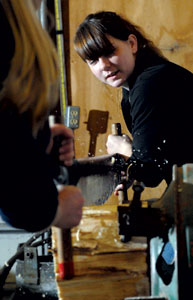There’s just something about swinging an axe that gets Amanda Brandt’s blood flowing.
“It’s addicting,” she said. “It really is. It’s totally different than anything I’ve ever done.”
When Brandt showed up at the Flathead Valley Community College Loggers’ first practice, the freshman didn’t know what to expect. Her friend Lynae Tripp had talked her into joining the team because “it was something to do” and, besides, Brandt figured she needed some kind of an extracurricular activity anyway. So she started swinging axes and sawing logs.
The FVCC Loggers are a sanctioned intercollegiate athletic team, though they are a decidedly alternative group of college athletes. Most of the Loggers come from logging backgrounds or at least outdoorsy upbringings. Some are simply curious. Many, like Brandt, have participated in extracurricular activities since childhood, but more of the 4-H than four-square ilk. They all pay for school by cutting wood.
As the coach of one of FVCC’s four intercollegiate sports, along with men’s and women’s soccer and cross country, coach Annie Beall has the ability to hand out scholarships to her athletes, something intramural club teams can’t do. Colby Auckland, the team’s captain and a third-year student at the two-year college, is the first to admit that the scholarship helps him finish school at his own pace. Auckland is an apt representative for the team, coming from a long line of loggers and, as a result, grasping how it was done in the old days: with crosscut saws, axes and perpetually bruised hands – like logging sports.
“> |
|
Amanda Brandt, right, and Meg Bartlett work as a team to cut through a piece of cottonwood while practicing the double buck event at the logger sports practice area. |
“I’ve been aware of the old-time logging tradition for a while,” he said. “I have it flowing in my blood.”
The Loggers have an almost startling winning tradition considering they are usually the only two-year college to show up at competitions. Beall said since she took over in 1988, the Loggers have had separate championship winning streaks of three, four and five in the Association of Western Forestry Clubs (AWFC). They’ve placed first or second at almost every AWFC competition, which is the “Super Bowl of logging sports,” as Beall says. The past couple of years have been slow, though.
“It’s been a while since we dominated,” Beall said.
This year’s team features eight newcomers, which bodes well for both the spring season and next year. Spring is the big season in logging sports, as there are more events, including the AWFC competition and more loggers join the team because by then word has spread. A lot of students, Beall said, don’t even know the Loggers exist, especially in the fall when freshmen are new to campus. The Loggers didn’t place at their only fall competition on Nov. 10 at Oregon State University, though they had two men and one woman place in different events. The University of Montana finished first.
Beall said it’s vital for the team’s success to have women like Brandt and Tripp join the team. Logging sports, Beall said, are unique amongst athletics in that teams depend on both women and men for points, as opposed to separating the genders into their own categories. Brandt and Tripp are two of four females on the team.
“You win and lose with your women,” Beall said.
Logging teams must be self-sufficient. The Loggers built their arena with helpful woodchip and log donations from timber companies. Before every practice and competition they go through the meticulous preparation process of taking the bark off of each log, drawing the hitting lines and forming footholds for the horizontal axe-chopping events. When the team needs more practice logs, they go knock on doors, especially those of farmers living close to the river, and ask if the property owners could spare a couple of cottonwoods.
“We’ll ask people if we could drop a couple trees on their land for competition,” Auckland said.
 |
|
Sean Mullen draws his saw through a piece of cottonwood while practicing the single buck at Flathead Valley Community College’s logger sports practice. |
The Loggers are using a new practice arena this year and for the first time they have their own indoor facility with a wood-burning stove to make fall practices a little less brutal. Beall thanked FVCC President Jane Karas for giving them the arena space and warehouse, which are both located behind Hutton Ranch Plaza.
Hugh Adams, who was a renowned figure in professional logging sports, started FVCC’s logging sports team in 1972. It was also Adams who approached Beall in her forestry class in 1984 about participating on the team. She has been involved ever since, with three years as an athlete and the rest as a coach. Before going to FVCC, Beall played basketball and volleyball at Northern Colorado University, which both had their moments, but don’t compare to the uniqueness of logging sports, she said.
Whereas in most sports the opposing team is the sworn enemy, in logging sports participants understand they are all of the same small culture – they actually help each other set up and share equipment.
“This sport is unlike any other sport,” she said. “You’ll have best friends on the other team.”
In logging sports, categories range from the co-ed crosscut sawing competition called the Jack and Jill Buck to the single buck to the pole climb to the vertical speed chop with an axe. There is also an axe throw competition, as well as a variety of other events. But most athletes, like Brandt, favor the horizontal speed chop or hard hit, where the axe-wielders carve out two footholds on a log a couple feet long, stand on it and then chop away at the part of wood exposed between their feet.
“You just have fun,” said Isaac Hall, a first-year logger. “That about sums it up. Everybody wants to be here.”